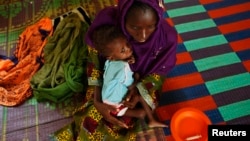PARIS —
Sub-Saharan Africa has some of the world's highest rates of chronic malnutrition among children. Now, the United Nations children's agency has put a price tag on it: $25 billion a year. That's the conclusion of a UNICEF conference on child malnutrition that wrapped up Wednesday in Paris.
The effects of hunger often are obvious. Think about the images of skeletal children during the recent droughts in Africa's Sahel and the Horn of Africa. Stunting, or chronic malnutrition, is less easy to detect - but its effects can be equally devastating.
Worldwide, cases of chronic malnutrition have shrunk dramatically in recent decades, though much less so in Africa. UNICEF estimates that chronic child malnutrition costs African countries a staggering $25 billion a year in loss of productivity and health costs that otherwise might have been avoided.
That's one reason UNICEF France hosted a two-day international conference on chronic malnutrition in sub-Saharan Africa. Gathering humanitarian agencies and representatives from 35 African countries, it comes just weeks before G8 leaders discuss ways to combat malnutrition at a summit in Northern Ireland.
"It's proven that because of chronic malnutrition, children can miss two to three years of school," said Laurent Duvillier, UNICEF's regional spokesman for West and Central Africa. "So actually, in the case of sub-Saharan Africa, we realize that those countries actually need that qualified manpower, but they may not have those intellectuals, those engineers, those doctors that they actually need because those children cannot reach their potential and their development as they should," said Laurent Duvillier is UNICEF's regional spokesman for West and Central Africa.
Chronic malnutrition often is described as a "hidden hunger." That's because chronically malnourished children may look normal, but in fact their physical and mental growth is impaired. Treating them during the first 1,000 days of their lives is critical, and Duvillier said experts agree the focus should be on the poorest children.
"It's very important that we have an integrated response, that will encompass to appropriate food but also access to safe, drinkable water and access to a health care system. And that's the difficulty of it," said Duvillier.
If the effects of chronic malnutrition are costly, experts say treating it is not. And UNICEF estimates that even modest investments in combating chronic malnutrition among children can yield stunning returns.
The effects of hunger often are obvious. Think about the images of skeletal children during the recent droughts in Africa's Sahel and the Horn of Africa. Stunting, or chronic malnutrition, is less easy to detect - but its effects can be equally devastating.
Worldwide, cases of chronic malnutrition have shrunk dramatically in recent decades, though much less so in Africa. UNICEF estimates that chronic child malnutrition costs African countries a staggering $25 billion a year in loss of productivity and health costs that otherwise might have been avoided.
That's one reason UNICEF France hosted a two-day international conference on chronic malnutrition in sub-Saharan Africa. Gathering humanitarian agencies and representatives from 35 African countries, it comes just weeks before G8 leaders discuss ways to combat malnutrition at a summit in Northern Ireland.
"It's proven that because of chronic malnutrition, children can miss two to three years of school," said Laurent Duvillier, UNICEF's regional spokesman for West and Central Africa. "So actually, in the case of sub-Saharan Africa, we realize that those countries actually need that qualified manpower, but they may not have those intellectuals, those engineers, those doctors that they actually need because those children cannot reach their potential and their development as they should," said Laurent Duvillier is UNICEF's regional spokesman for West and Central Africa.
Chronic malnutrition often is described as a "hidden hunger." That's because chronically malnourished children may look normal, but in fact their physical and mental growth is impaired. Treating them during the first 1,000 days of their lives is critical, and Duvillier said experts agree the focus should be on the poorest children.
"It's very important that we have an integrated response, that will encompass to appropriate food but also access to safe, drinkable water and access to a health care system. And that's the difficulty of it," said Duvillier.
If the effects of chronic malnutrition are costly, experts say treating it is not. And UNICEF estimates that even modest investments in combating chronic malnutrition among children can yield stunning returns.










